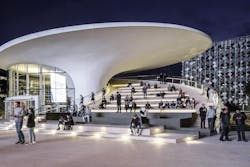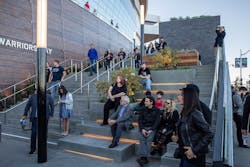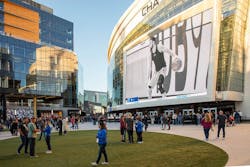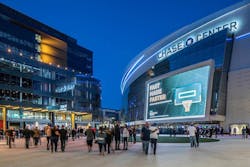SWA designs people-centric landscape and public realm for Chase Center
By David Malone, Associate Editor
Chase Center, the Golden State Warriors new San Francisco home, is more than just a 18,064-seat arena for watching basketball. Programmed activities extend outside of the building’s walls and spill onto the surrounding area, creating a new major public open space for the city.
Designed by SWA, the pedestrian-friendly, year-round destination includes 100,000 sf of retail space and 3.2 acres of plazas, public open space, and adjacent office buildings and art installations. The public space becomes an entertainment venue in its own right as its series of outdoor spaces and performance/gathering areas are programmed to either complement events in the Chase Center or stand on their own.
The modular landscape, which was designed as a series of outdoor living rooms that can remake and animate the space as needed, was designed to serve a dual purpose. It directs circulation by guiding thousands of visitors to and from the arena, but it also offers a number of gathering spaces to accommodate those who want to relax and enjoy the offering of seasonal activities. Custom designed planters/seating modules can be moved by forklift to create space for ice skating, farmer’s markets, a car show, or an instant micro-garden.
“This is an urban mixed-use project and as such, it’s a bit of a chameleon," notes Rene Bihan, Managing Principal, SWA. “Neighbors can dine alongside the growing workforce and fans of sports and music. We designed the site to offer an urban stroll through a series of connected spaces that change with seasonal and event programming.”
See Also: Sports teams get in the game: Mixed-use developments are using sports stadiums as their anchors
Two of the projects major features are a 35,000-sf central plaza that doubles as an event space and a 25,000-sf triangular plaza that hosts a permanent installation titled “Seeing Spheres” by Danish artist Olafur Eliasson. A wide, spiraling pedestrian path connects the spaces as it rises and curves alongside the arena, echoing the form of the arena and offering terraces and view platforms of the bay. The spiral theme is also repeated in the landscape through the site’s paving, with stainless steel bands embedded to convey a sense of circular movement, and in the scoring pattern of cast-in-place concrete. On the city side, pathways with seating connect to the ground plane to draw pedestrians from nearby transit and neighborhoods into the plaza’s central space.
A garden along 3rd Street provides a learning experience by showing the bio-filtration process by which plants help to cleanse all rain water on site. Additional native California plants exist throughout the ten-acre parcel of land to conserve water, provide shade canopy, and unify the area’s character.



